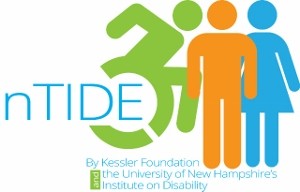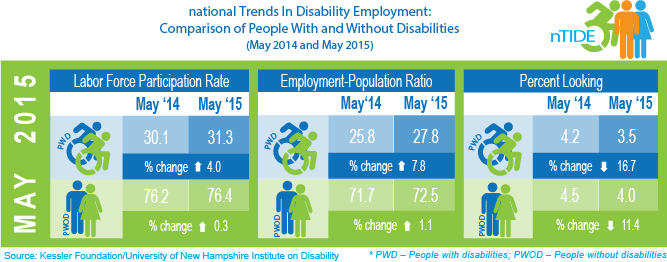
July 2, 2015
There are new reports on the amount of Americans with disabilities that are currently entering the workforce. Kessler foundation recently reports about the statistics and the successes of the programs implemented in the U.S. Below is an excerpt from the Kessler foundation and the full article can be found in the link below.
“The economy continues to grow as more Americans with and without disabilities enter the workforce, according to today’s National Trends in Disability Employment – Monthly Update (nTIDE), issued by Kessler Foundation and University of New Hampshire’s Institute on Disability (UNH-IOD). A recent survey shows that people with disabilities are striving to enter the workforce and seeking more hours.
In the Bureau of Labor Statistics’ Jobs Report released Friday, June 5, the employment-to-population ratio for working-age people with disabilities increased from 25.8 percent in June 2014 to 27.8 percent in June 2015 (up 7.8 percent; 2.0 percentage points). For working-age people without disabilities, the employment-to-population ratio also increased slightly from 71.7 percent in June 2014 to 72.5 percent in June 2015 (up 1.1 percent; 0.8 percentage points). The employment-to-population ratio, a key indicator, reflects the percentage of people who are working relative to the total population (the number of people working divided by the number of people in the total population multiplied by 100). In comparison to June 2014, 430,000 more Americans with disabilities are in the workforce.
“We have seen more Americans with disabilities becoming employed over the past eight months, relative to the same months in the previous year,” according to John O’Neill, Ph.D., director of employment and disability research at Kessler Foundation. “Most notably, the gains for people with disabilities have outstripped the gains made by people without disabilities. This continued good news is qualified by the fact that there remains an employment gap of 44.7 percent between people with and without disabilities.” (The employment gap is the difference in the employment-to-population ratios between people with and without disabilities.)
For people with disabilities, the labor force participation rate also increased from 30.1 percent in June 2014 to 31.3 percent in June 2015 (up 4.0 percent; 1.2 percentage points). For people without disabilities, the labor force participation rate increased slightly from 76.2 percent in June 2014 to 76.4 percent in June 2015 (up 0.3 percent; 0.2 percentage points). The labor force participation rate is the percentage of the population that is working or actively looking for work. ”

Continue reading the article on the Kessler Foundation.
